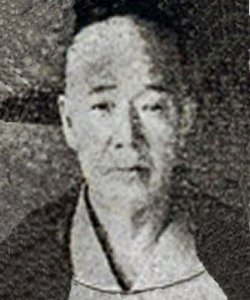| |
GEKKO(1859 - 1920)Biography |
|
 |
||
| click
on picture for another photo |
On recommendation of his father, Gekkō taught himself in art. He began decorating porcelain and rickshaws for a living, and designed flyers for the nearby brothel quarters. His early style shows the influence of the painter Kikuchi Yōsai. About 1881, in conjunction with his adoption, he took the surname Ogata at the insistence of a descendant of the painter Ogata Kōrin. He soon was designing prints and illustrating books and newspapers. In 1885 Gekkō exhibited in the Painting Appreciation Society.
The First Sino-Japanese (1894/1895) war was the subject of a number of triptychs he designed during that time. While many of these war prints were merely aimed at illustrating the events and were created by artists who are not known for any other works, the war prints created by Gekko have an artistic value of their own. Gekko even accompanied the troops as a war correspondent for a Japanese newspaper. Back at home he transformed his numerous sketches into prints.
From the 1890s Gekkō won a number of art prizes, both national and international. He was one of the earliest Japanese artists to win international attention. He was a judge in the Japan Youth Painting Association, in which he was involved and helped founding in 1891.
Although OGATA Gekkō's graphics make a modern impression, the artist supposed himself as part of the traditional art of Japanese woodblock. His origins as illustrator and his preferences for drawing and painting are visible in his prints. He probably never underwent the traditional apprenticeship in any of the printmaking schools. Some believe, he had been a pupil of Yoshitoshi Tsukioka (Taiso). But his style does not support this theory. Gekkō's work was originally closely based upon that of Kikuchi Yōsai, and he was also inspired by Hokusai, creating a series of one hundred prints of Mount Fuji. However, he did develop his own style, with significant stylistic elements from nihonga.
When he turned to printmaking, his personal different style created some problems for the block carvers and printers. They were used to clear lines and separated areas of the same color. Art critics say that Gekko tried to imitate the brush stroke in his prints. One of Ogata's favorite subjects are natural prints. His kacho-e - bird prints - are numerous. He had a special skill for the details of the plumage of the birds. Later Koson (Shoson) Ohara, a shin hanga artist, developed a similar mastership in depicting the birds' plumage.
He contributed to preserve traditional values, as to be seen in Gekko's historical series. Another important theme of Gekko's graphics are genre scenes from everyday life of his contemporaries, like mothers with their children, or children playing in the street. These pictures give an interesting insight into life in Japan at the turn of the 19th and 20th centuries.
Personal life - Geko was married for two times.
In 1888, he wed
his art student TAI Kiku, and changed his name to TAI
Masanosuke. Gekkō died on 1 October 1920 in Shin-Ogawamachi,
and was buried in the Ushigome Ward of Tokyo at age 61.
Aliases - His art names include Ogata Gekkō, Ogata
Masanosuke, Kagyōrō, Meikyōsai, Kiyū, Kagyōsai, Meikyōsai,
Nagami Shōnosuke, Nen'yū, and Tai Masanosuke
Disciples - He had few students, the best-known of whom was Kōgyo Tsukioka, the adopted son of Yoshitoshi.
Copyright 2008 ff: Hans P. Boehme